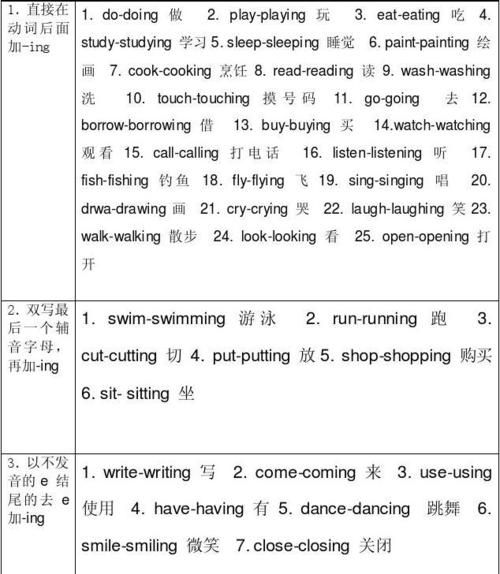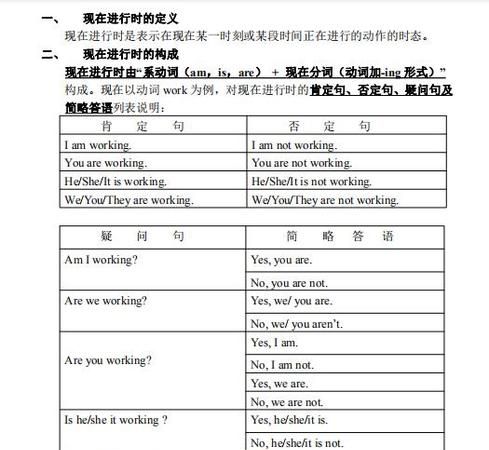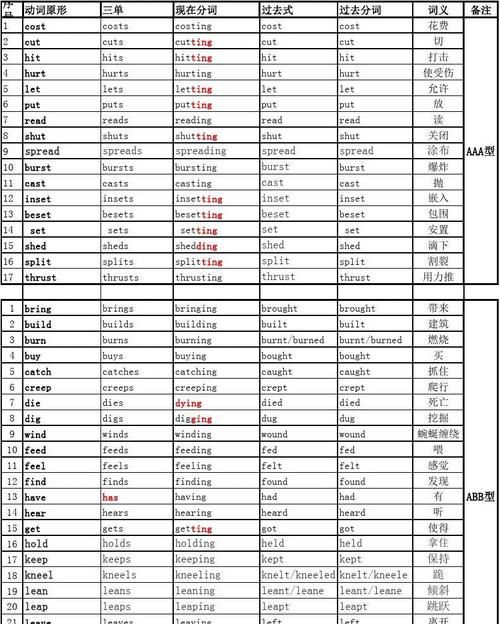一提到现在分词变化规则五年级 网上众说纷纭,今天就给家解读一下。动词原形变ing形式,变化规则是什么?和现在分词变化规则现在分词变化规则五年级 的内容,好让您知道现在分词的变化规则,来深入了解。
现在分词变化规则五年级 :动词过去分词和 现在分词的变化规则
动词过去分词:可分为规则动词和不规则动词。规则动词加ed,方法有:一般加ed;以e结尾的加d;辅音加y
,变y
为i,加ed
;重读闭音节要双写最后一个字母加ed.play---
played
live---
lived
carry---
carried
stop----stopped
不规则动词:
come--came--come
go---went--gone
现在分词的变化规则加ing
.一般加ing;以e结尾,去e加ing;重读闭音节,双写最后一个字母加ing.work---
working
make---
making
swim---
swimming

现在分词变化规则五年级 :现在分词变化规则是怎样的
现在分词变化规则是:
1、一般情况直接加-ing;
2、以不发音的e、ue结尾的动词去e, 加-ing;
3、以重读闭音节结尾的动词,并且末尾只有一个辅音字母,最后一个字母不是x的动词ut ----- cutting
put ----- putting
begin ------ beginning
,双写最后一个字母,再加ing;
run——running

注意:rain——raining(不要问我为什么,因为词典上就这么写的)
4、以ie结尾的动词变ie为y,再加-ing;
lie ----- lying
tie ----- tying
die ----- dying
5、以c结尾的动词变c为ck,再加-ing;
6、以l结尾的动词 如果动词原形以非重读音节结尾,则末尾的字母l双写与不双写均可;
7、部分以-p结尾的动词同样遵循第6条,这类词多由“前缀+名词”构成。 如果动词原形以非重读音节结尾,则末尾的字母p双写与不双写均可。
现在分词变化规则五年级 :动词的现在分词变化规律
一 现在分词的结构:
现在分词就是动词加上ing 构成,下面是各种时态和语态的构成: 主动语态 被动语态
一般现在时 Doing Being done
现在完成时 Having done Having been done
例句:
1 The girl sitting in the front is my cousin.
2 Having fulfilled the mission, they returned to their company.
3 Being protected by his bodyguard, he felt safe wherever he went.
4 Having been invited, she had to go.
二 现在分词的功能:
A 作表语:
当现在分词作表语时, 现在分词可以简单地被看作是形容词。
The news is interesting.
The problem is confusing.
His speech is encouraging.
区别:
{ a His speech is encouraging.
b He is encouraging me now.
a 中encouraging是形容词表示主语的特征。
b 中encouraging是现在进行时表示主语发出的动作。
B 作定语:
当现在分词作定语时,它相当于一个定语从句。
互换 { In my hometown, there is a factory making cars.
In my hometown, there is a factory that makes cars.
互换 { The girl writing a letter is good at English.
The girl who is writing a letter is good at English.
互换 { The problem being discussed is very important.
The problem that is being discussed is very important.
注意:
• 通常情况下,单个的现在分词放在被修饰词的前面,现在分词短语放在被修饰词的后面。
This is a piece of encouraging news.
This is a piece of news encouraging us to work hard.
• 像非限定定语从句用逗号隔开一样,现在分词也有非限定形式---用逗号隔开。
互换 { His daughter, who is working in the hospital, is going to study abroad.
His daughter, working in the hospital, is going to study abroad.
C 作状语:
当现在分词作状语时,它相当于一个状语从句。
互换 { Leaving the airport, he waved to us again and again.
When he left the airport, he waved to us again and again.
互换 { Seeing nobody at home, she decided to leave them a note.
Because she saw nobody at home, she decided to leave them a note.
互换 { Turning to the right, you will find the hospital.
If you turn to the right, you will find the hospital.
互换 { Knowing where his uncle lives, he never goes to see him.
Although he knows where his uncle lives, he never goes to see him.
注意:
有时候我们可以在现在分词前面加上连词。意思和不加连词一样。
互换 { When he left the airport, he waved to us again and again.
Leaving the airport, he waved to us again and again.
When leaving the airport, he waved to us again and again.
互换 { Because she saw nobody at home, she decided to leave them a note.
Seeing nobody at home, she decided to leave them a note.
Because seeing nobody at home, she decided to leave them a note.
D 作宾语补足语和主语补足语(进一步地补充说明宾语,主语是一个什么样子):
宾语补足语 { I heard him….
I heard him crying in the corner.
主语补足语
{ He was heard….
He was heard crying in the corner.
区别:
a I heard him sing a pop song in the room.
b I heard him singing a pop song in the room.
a是省略to的动词不定式作宾语补足语来表示结果---宾语作了某事。
b是现在分词作宾语补足语来表示正在进行的动作---宾语正在干某事。
E 作独立主格:
当我们在使用现在分词作状语时,现在分词的动作发出者必须和主句谓语动词的动作发出者是同一个人或物。如果动作发出者不是同一人或物,不能使用现在分词,必须使用独立主格。
对: Standing on the top of the hill, I found the city very beautiful.
I---standing AND I---found
错: Standing on the top of the hill, the city looks very beautiful.
I----standing BUT the city---looks
改正:
使用独立主格
I standing on the top of the hill, the city looks very beautiful.
• 独立主格的更多例子:
He walked over to me, a dog following him.
Class being over, the children went home.
Weather permitting, we will go outing next week.
His teacher having gone away to a conference, they did not have classes this week

现在分词变化规则五年级 :现在分词的变化规则
1、一般情况直接加-ing;
2、以不发音的e、ue结尾的动词去e, 加-ing;
3、以重读闭音节结尾的动词,并且末尾只有一个辅音字母,最后一个字母不是x的动词ut ----- cutting
put ----- putting
begin ------ beginning
,双写最后一个字母,再加ing;
run——running
注意:rain——raining(不要问我为什么,因为词典上就这么写的)
4、以ie结尾的动词变ie为y,再加-ing;
lie ----- lying
tie ----- tying
die ----- dying
5、以c结尾的动词变c为ck,再加-ing;
6、以l结尾的动词 如果动词原形以非重读音节结尾,则末尾的字母l双写与不双写均可;
7、部分以-p结尾的动词同样遵循第6条,这类词多由“前缀+名词”构成。 如果动词原形以非重读音节结尾,则末尾的字母p双写与不双写均可。

以上就是关于现在分词变化规则五年级 ,现在分词的变化规则的全部内容,以及现在分词变化规则五年级 的相关内容,希望能够帮到您。

